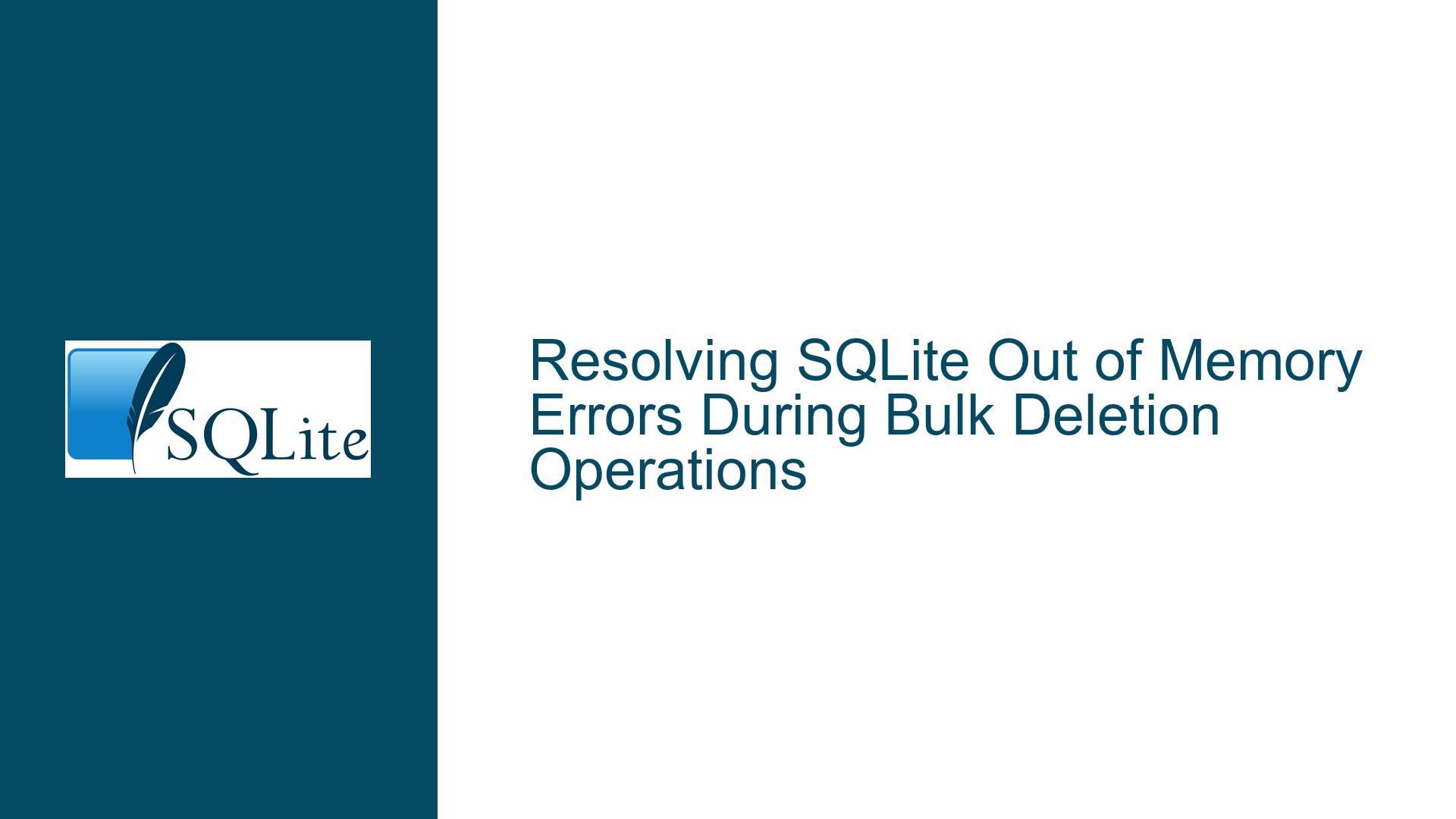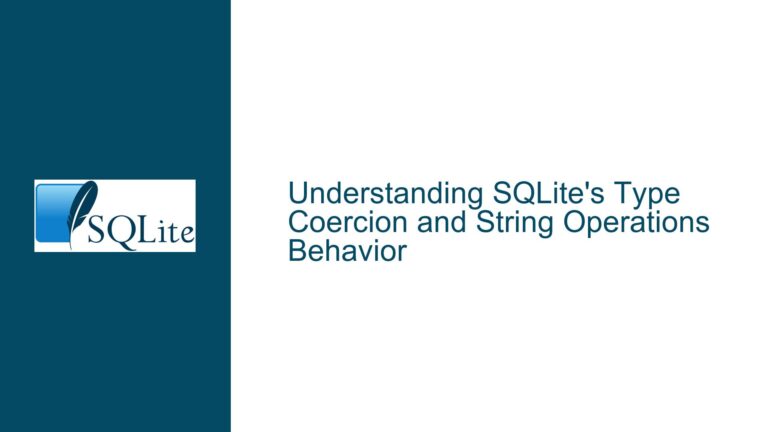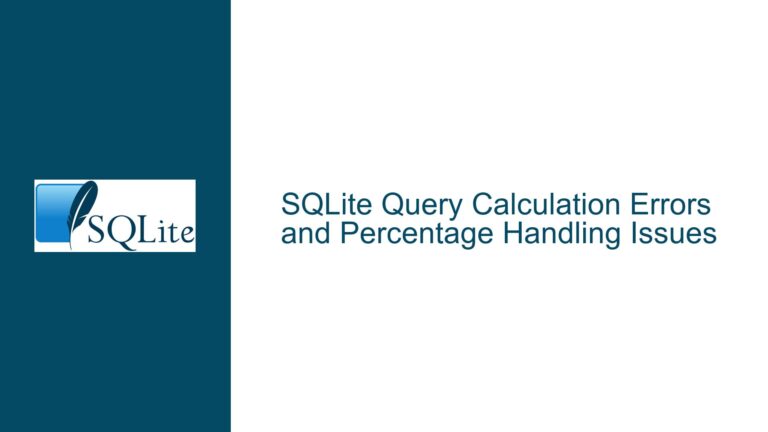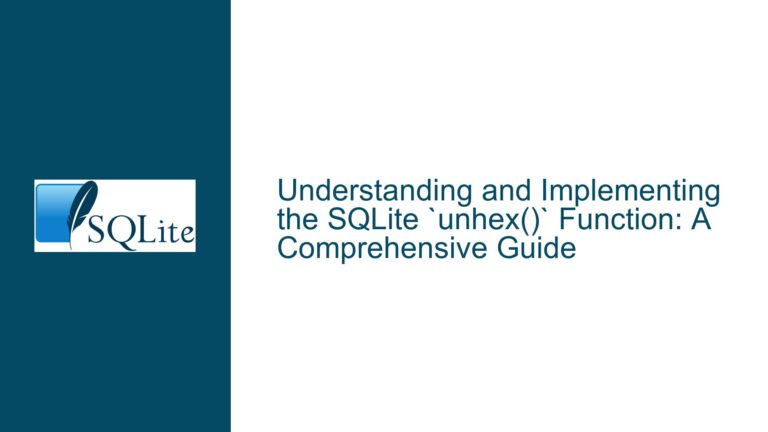Resolving SQLite Out of Memory Errors During Bulk Deletion Operations
Understanding the SQLite Out of Memory Error During Conditional Deletion
The "out of memory" error in SQLite during a DELETE operation with a WHERE clause and LIMIT is a critical failure that occurs when the database engine exhausts available memory resources while attempting to execute the query. This error is particularly common in constrained environments such as mobile devices or embedded systems, where memory allocation is limited. The root cause often lies in inefficient query design, lack of indexing, or improper configuration of the SQLite library. To resolve this issue, developers must address multiple layers of the problem: schema design, query optimization, memory management, and SQLite compilation flags.
Key Factors Contributing to Memory Exhaustion in Conditional Deletion
1. Absence of Indexes on Filtered Columns
When a DELETE query includes a WHERE clause with multiple conditions, SQLite must locate all rows that match the criteria. Without indexes on the columns used in the filter (e.g., DTEINSPECTEDTICKETDATETIME, BUPLOADED, BMOVED, STRWAYBILLNO), the database performs a full table scan. This process loads entire rows into memory, which becomes unsustainable for large tables (e.g., 24,400+ rows). The temporary storage required to track matching rows during deletion can exceed available memory, especially on devices with limited RAM.
2. Misuse of the DATE() Function on Unindexed DateTime Columns
Applying the DATE() function to a datetime column (DTEINSPECTEDTICKETDATETIME) prevents SQLite from leveraging any existing index on that column. For example, DATE(DTEINSPECTEDTICKETDATETIME) <= '2022-02-11' forces SQLite to compute the date component for every row in the table, rather than performing a range scan using an index. This increases CPU and memory usage during query execution.
3. Unoptimized Subqueries in DELETE Operations
Rewriting the DELETE query to use a subquery (e.g., INTINSPECTEDTICKETID IN (SELECT ...)) introduces additional overhead. If the subquery itself lacks optimization, SQLite may materialize intermediate results in memory, doubling the memory footprint. This is exacerbated when the subquery includes the same unindexed conditions as the outer DELETE statement.
4. Missing SQLITE_ENABLE_UPDATE_DELETE_LIMIT Compilation Flag
The LIMIT clause in DELETE statements is not enabled by default in standard SQLite builds. If the SQLite library was compiled without SQLITE_ENABLE_UPDATE_DELETE_LIMIT, the LIMIT clause is ignored, causing the database to attempt deleting all matching rows at once instead of in batches. This leads to a single large transaction that consumes excessive memory.
5. Insufficient Memory Allocation for SQLite Operations
Mobile devices often restrict the memory available to applications. SQLite’s default memory management (e.g., page cache, temporary storage) may exceed these limits during large deletions. This is especially problematic when using the MEMSYS5 memory allocator, which operates within a fixed memory pool.
Comprehensive Strategies to Resolve SQLite Out of Memory Errors
1. Implement Targeted Indexing for Delete Filter Conditions
Create a composite index covering all columns used in the WHERE clause and sorting. For the given query:
CREATE INDEX idx_inspected_ticket ON TBLINSPECTEDTICKETDETAIL (
DTEINSPECTEDTICKETDATETIME,
BUPLOADED,
BMOVED,
STRWAYBILLNO
);
This index allows SQLite to quickly locate rows matching BUPLOADED = 1, BMOVED = 1, and STRWAYBILLNO != 'W2001220866', while also supporting range scans on DTEINSPECTEDTICKETDATETIME.
Avoid Function-Based Filters:
Rewrite the date filter to use a range comparison instead of DATE():
DTEINSPECTEDTICKETDATETIME <= '2022-02-11 23:59:59'
This enables the use of an index on DTEINSPECTEDTICKETDATETIME and eliminates per-row computations.
2. Recompile SQLite with the LIMIT Clause Enabled
If batch deletion via LIMIT is required, rebuild the SQLite library with the SQLITE_ENABLE_UPDATE_DELETE_LIMIT flag:
./configure --enable-update-delete-limit
make
Replace the existing SQLite library in your application with the newly compiled version. This ensures that DELETE ... LIMIT operates as intended, allowing controlled batch deletions.
3. Optimize Delete Batches Using RowID Segmentation
For environments where recompiling SQLite is impractical, manually batch deletions using ascending ROWID ranges:
DELETE FROM TBLINSPECTEDTICKETDETAIL
WHERE ROWID IN (
SELECT ROWID FROM TBLINSPECTEDTICKETDETAIL
WHERE /* conditions */
ORDER BY ROWID LIMIT 300
);
This approach avoids memory exhaustion by processing rows in small, deterministic chunks.
4. Adjust SQLite Memory Configuration
Increase the memory limits using pragmas:
PRAGMA cache_size = -20000; -- Allocate 20,000 pages (approx. 32MB)
PRAGMA temp_store = MEMORY; -- Use RAM for temporary storage
Monitor memory usage during deletions using sqlite3_memory_used() and adjust these values based on device constraints.
5. Leverage Transaction Boundaries to Reduce Memory Pressure
Wrap each batch deletion in an explicit transaction to limit the number of dirty pages in memory:
BEGIN IMMEDIATE;
DELETE FROM TBLINSPECTEDTICKETDETAIL WHERE ... LIMIT 300;
COMMIT;
This forces SQLite to flush changes to disk after each batch, freeing up memory for subsequent operations.
6. Profile Query Execution with EXPLAIN QUERY PLAN
Analyze the efficiency of the DELETE query using:
EXPLAIN QUERY PLAN
DELETE FROM TBLINSPECTEDTICKETDETAIL WHERE ...;
Verify that the output indicates index usage (e.g., USING INDEX idx_inspected_ticket). If a full table scan (SCAN TABLE TBLINSPECTEDTICKETDETAIL) is reported, revisit index design.
7. Mitigate Subquery Materialization Overhead
Replace the subquery-based DELETE with a join-based approach to avoid temporary table creation:
DELETE FROM TBLINSPECTEDTICKETDETAIL
WHERE ROWID IN (
SELECT T.ROWID FROM TBLINSPECTEDTICKETDETAIL T
WHERE /* conditions */
LIMIT 300
);
The ROWID IN (SELECT ...) pattern allows SQLite to optimize the subquery execution, reducing memory usage.
8. Schedule Incremental Deletion During Off-Peak Times
If the device is resource-constrained, trigger deletions during periods of low activity. Use smaller batch sizes (e.g., LIMIT 10) and insert delays between batches to allow memory recovery.
9. Monitor and Trim Database File Fragmentation
Frequent deletions can fragment the database file, increasing memory usage during vacuum operations. Periodically run:
PRAGMA incremental_vacuum;
This reclaims free pages without requiring a full VACUUM, which is memory-intensive.
10. Evaluate Alternative Storage Engines or Architectures
For datasets exceeding device memory limits, consider:
- Sharding the table by date ranges.
- Offloading historical data to a cloud database.
- Using SQLite’s ATTACH DATABASE feature to split data across multiple files.
By systematically addressing indexing, query structure, memory configuration, and SQLite compilation settings, developers can eliminate "out of memory" errors during bulk deletions. The key is to minimize the working data set size in memory through efficient indexing and batched operations, while tailoring SQLite’s behavior to the constraints of the target environment.






